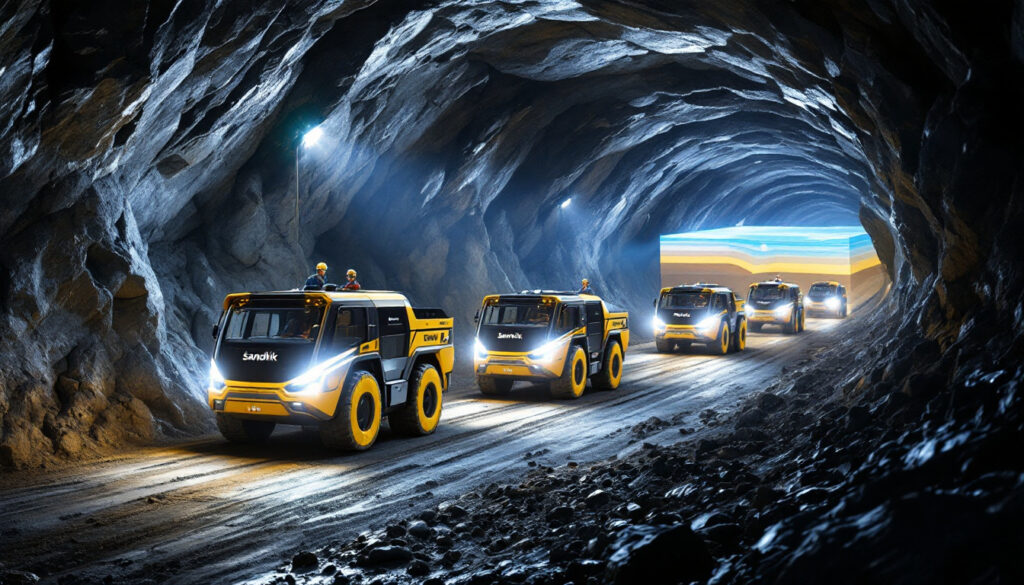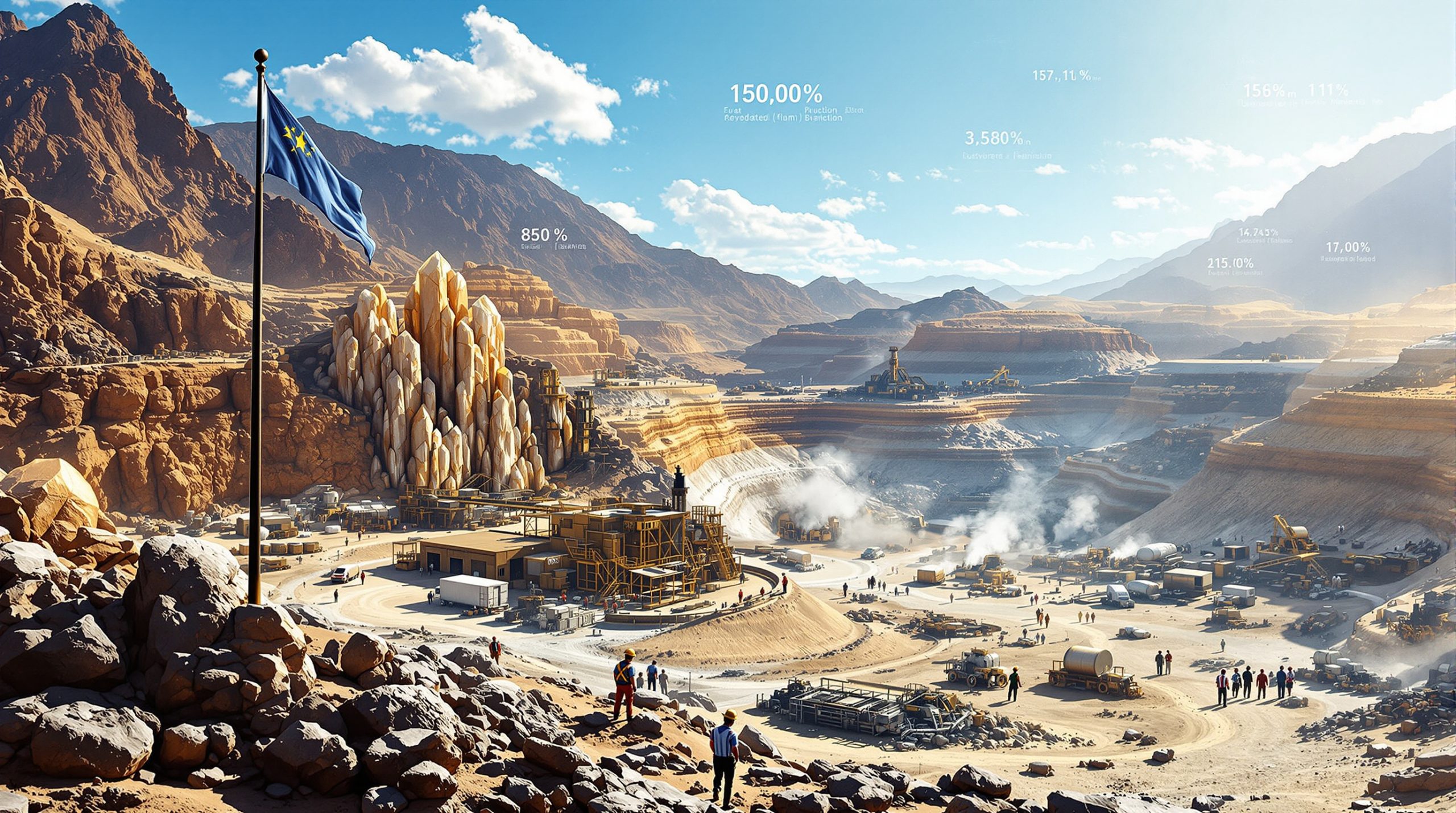Understanding South32's Landmark Battery-Electric Vehicle Contract
Sandvik Mining and Rock Solutions has secured a groundbreaking contract to supply 22 battery-electric vehicles (BEVs) to South32's Hermosa project in Arizona. This deal represents Sandvik's largest-ever BEV fleet deployment in mining history, forming part of a comprehensive 42-unit underground equipment fleet. The phased delivery schedule will commence in Q4 2026 and continue through 2030, aligning perfectly with South32's production timeline.
"This record-breaking contract demonstrates the mining industry's accelerating transition toward sustainable operations," notes Mats Eriksson, President of Sandvik Mining and Rock Solutions. "Our purpose-built battery-electric vehicles will enable South32 to establish one of North America's most environmentally advanced mining operations."
The strategic significance of this agreement extends beyond mere equipment procurement. It represents a fundamental shift in how critical mineral projects are being developed in North America, with decarbonisation in mining now central to operational planning rather than peripheral concerns.
The Record-Breaking BEV Fleet Agreement
The 22-vehicle battery-electric fleet will include a comprehensive range of underground mining equipment, from loaders and trucks to auxiliary support vehicles. This represents a significant departure from conventional diesel-powered mining operations and underscores South32's commitment to sustainable mining practices.
Industry analysts have noted that while the upfront investment in BEV technology is higher than diesel alternatives, the long-term operational benefits—including reduced ventilation requirements, lower maintenance costs, and extended equipment lifespan—create compelling economic incentives beyond environmental considerations.
"This BEV fleet implementation will be carefully orchestrated to align with Hermosa's development timeline," explains Eriksson. "The phased delivery approach ensures seamless integration with the mine's evolving infrastructure requirements while providing operational flexibility during the critical production ramp-up period."
The Strategic Importance of the Hermosa Project
The Hermosa project represents a pivotal development in the U.S. critical minerals landscape. Located in Santa Cruz County, Arizona, this greenfield initiative is poised to become one of North America's most significant sources of zinc, lead, silver, and manganese when production commences in 2027.
"Hermosa isn't just another mining project—it's strategically vital to American mineral security," states Pat Risner, President of South32 Hermosa. "Our zinc deposit is the only one of its size discovered globally in the past decade, and we're uniquely positioned as the only advanced mine development in the United States capable of producing two federally designated critical minerals."
The project's significance is magnified by its battery-grade manganese deposit, which features substantial exploration potential beyond current resource estimates. Geological assessments indicate mineralization patterns similar to world-class deposits in Africa's Kalahari Manganese Field, suggesting Hermosa's resources may be even more extensive than currently documented.
With a projected operational lifespan measured in decades rather than years, Hermosa represents a long-term strategic asset in South32's global portfolio and a cornerstone of North American critical mineral production capacity.
How Will Battery-Electric Vehicles Transform Mining Operations?
The introduction of battery-electric vehicles into underground mining operations represents a paradigm shift in industry practices, with transformative implications for operational economics, environmental impact, and worker safety.
Economic Benefits of BEV Implementation
The economic case for BEV adoption in mining has strengthened considerably as technology has matured. While BEVs typically require 25-30% higher initial capital investment than diesel equivalents, this premium is increasingly offset by operational advantages over equipment lifespans.
"Lower fuel expenses and reduced maintenance costs are just the beginning," explains Eriksson. "BEVs enable a more efficient, economical, and sustainable mining operation across multiple dimensions."
The maintenance economics are particularly compelling. BEVs contain approximately 30% fewer moving parts than diesel equivalents, translating to maintenance cost reductions ranging from 20-30% according to Sandvik case studies. Oil changes and exhaust system maintenance—significant recurring expenses for diesel fleets—are eliminated entirely.
Energy efficiency represents another economic advantage. Electric drivetrains typically convert 85-90% of stored energy to mechanical work, compared to roughly 30-35% for diesel engines. This efficiency differential becomes increasingly significant as mining operations extend to deeper levels where ventilation and cooling costs escalate dramatically.
"The total cost of ownership analysis overwhelmingly favors BEVs, particularly in new developments where ventilation infrastructure can be optimized from the outset," notes mining economist Jonathan Barclay. "For Hermosa, we're looking at potential operational savings of 15-20% over traditional diesel operations when factoring in all variables."
Environmental Impact and Sustainability Advantages
The environmental benefits of BEV implementation extend far beyond reduced carbon emissions, though this aspect alone is substantial. Mining operations typically contribute 4-7% of global greenhouse gas emissions, with underground diesel equipment representing a significant component of this footprint.
"BEV adoption directly supports the electrification of society and the global green transition," states Eriksson. "By eliminating diesel emissions from confined underground spaces, we're not just reducing carbon—we're fundamentally transforming the environmental profile of mining operations."
The ventilation requirements for underground mines represent a major energy consumption factor, with some operations dedicating 30-40% of their total energy budget to ventilation systems. BEVs can reduce these requirements by up to 50%, creating cascading efficiency benefits throughout operations.
"When you eliminate diesel particulate matter and nitrogen oxides from the underground environment, you're addressing both climate impact and worker health simultaneously," explains environmental engineer Dr. Sarah Lin. "The reduced heat generation from electric motors also minimizes cooling requirements in deep operations, creating another energy efficiency multiplier."
For Hermosa specifically, the reduced environmental footprint aligns with South32's broader ESG in mining operations and enhances the project's social license to operate in an environmentally sensitive region of Arizona.
The Critical Minerals Significance of the Hermosa Project
The Hermosa project's importance extends beyond its scale and technology implementation—it represents a strategic response to critical gaps in the North American mineral supply chain.
Addressing the Global Zinc Supply Gap
Zinc, despite its fundamental importance to infrastructure and renewable energy technologies, faces significant supply challenges. The International Lead and Zinc Study Group projects a four-million-metric-ton global critical mineral shortage by 2033, driven by depleting reserves, underinvestment in exploration, and increasing demand from green technologies.
"Zinc is essential for national security and infrastructure resilience," explains Risner. "It's the primary anti-corrosion coating for steel, vital for wind turbines, solar mounting systems, and transmission infrastructure. Yet remarkably, only 6% of zinc is currently mined in the United States despite its status as a critical mineral."
This supply vulnerability is particularly acute for high-grade zinc concentrates suitable for specialized applications. Hermosa's zinc deposit not only ranks within the top 10 globally by resource size but also features exceptionally high grades averaging above 10% zinc—more than double the global average for operating zinc mines.
"What makes Hermosa's zinc particularly valuable is its metallurgical profile," notes metallurgist Dr. James Chen. "The ore's high purity and limited penalties from deleterious elements make it ideal for high-specification galvanizing applications where substitution isn't feasible."
The discovery timing is equally significant. As Risner emphasizes, "Our zinc deposit is the only one of its size discovered in the past decade, period." This rarity underscores the exceptional nature of Hermosa within the global mineral exploration landscape.
South32's Strategic Position in Critical Minerals
With Hermosa's development, South32 is strategically positioning itself as a globally significant producer of critical minerals essential for energy transition technologies. The project's manganese deposit—known as Clark—contains high-purity, battery-grade manganese suitable for next-generation EV batteries.
"Hermosa will supply minerals essential for powering a clean energy future," states Risner. "We're targeting both traditional markets and emerging high-tech applications that support decarbonization."
The project's dual-deposit nature—zinc-lead-silver (Taylor deposit) and manganese (Clark deposit)—provides South32 with portfolio diversification and market flexibility as mineral demand patterns evolve. This positions the company at the forefront of sustainable mining practices while addressing critical supply chain vulnerabilities in the North American context.
Industry analysts note that Hermosa represents a cornerstone asset in South32's strategic pivot toward future-facing commodities. The company's investment in battery-electric mining equipment further reinforces this positioning, creating alignment between operational practices and end-market applications of its mineral products.
The Technology Behind Sandvik's BEV Mining Equipment
Sandvik's battery-electric vehicles represent the culmination of over a decade of focused R&D in electrified mining equipment, incorporating innovations from both mining engineering and automotive electrification.
Advantages of Sandvik's Battery-Electric Fleet
Unlike early BEV mining equipment that often adapted diesel designs, Sandvik's latest generation vehicles are purpose-built for electrification from the ground up. This design philosophy unlocks performance advantages beyond mere diesel replacement.
"Our BEVs are purpose-built for underground mining environments," explains Eriksson. "By eliminating diesel emissions in confined spaces, we're enabling mining companies to rethink ventilation requirements while dramatically improving working conditions."
The operational benefits are multi-dimensional. Sandvik's BEVs operate at noise levels below 70 decibels—comparable to normal conversation—versus 85-95 decibels for diesel equivalents. This reduction not only improves communication and safety but reduces worker fatigue and potential hearing damage over time.
Heat generation represents another significant advantage. Electric motors produce approximately 80% less heat than diesel engines for equivalent work, reducing cooling loads in thermally-constrained deep mining environments. This efficiency reduces both energy consumption and capital requirements for heat management infrastructure.
"The ventilation reduction potential is perhaps the most underappreciated benefit," notes mining ventilation specialist Thomas Harkins. "When you remove diesel particulate matter and exhaust gases from your ventilation equation, you can typically reduce airflow requirements by 40-50% for affected working areas."
Sandvik's BEVs also feature advanced telemetry and diagnostic systems that enable AI-powered fleet management and performance optimization. This data-driven approach allows operators to maximize equipment availability while minimizing unplanned downtime—a critical consideration for production-intensive operations like Hermosa.
Implementation Timeline and Logistics
The phased delivery schedule, beginning in Q4 2026 and continuing through 2030, aligns with Hermosa's progressive development timeline. This approach allows South32 to integrate BEVs into operations as underground infrastructure expands, optimizing capital deployment.
Initial deliveries will focus on development equipment for mine construction, with production units following as operational areas expand. This sequencing ensures that charging infrastructure and maintenance capabilities evolve in parallel with fleet requirements.
"The implementation timeline reflects both project requirements and technology evolution," explains mining equipment specialist Elena Rodriguez. "By staggering acquisitions through 2030, South32 gains access to successive generations of battery technology improvements while maintaining operational continuity."
Sandvik will provide comprehensive training and operational support throughout the implementation period, ensuring smooth transition from conventional equipment to battery-electric alternatives. This knowledge transfer component represents a significant aspect of the overall contract value, building South32's internal capabilities in digital transformation in mining.
FAQ: Battery-Electric Vehicles in Mining Operations
What are the main advantages of BEVs in underground mining?
Battery-electric vehicles deliver multiple operational advantages beyond environmental benefits. By eliminating diesel emissions in confined spaces, BEVs create healthier working environments with significantly reduced respiratory hazards. The ventilation requirements decrease by 30-50%, generating substantial energy savings and reduced infrastructure costs.
BEVs also produce significantly less noise (below 70dB versus 85-95dB for diesel), improving communication safety and reducing worker fatigue. The heat generation from electric motors is approximately 80% lower than diesel engines, decreasing cooling requirements in thermally-constrained environments.
From a maintenance perspective, electric drivetrains contain approximately 30% fewer moving parts than diesel equivalents, eliminating oil changes, exhaust system maintenance, and many traditional failure points. This simplification typically reduces maintenance costs by 20-30% while improving equipment availability.
How do BEVs contribute to mining sustainability goals?
BEVs address multiple dimensions of mining sustainability. The direct elimination of diesel consumption removes Scope 1 carbon emissions from equipment operation, with potential reductions of 1.5 gigatons CO2e across the mining sector by 2030 according to World Bank estimates.
Beyond carbon, BEVs eliminate diesel particulate matter—classified as a carcinogen by the WHO—and nitrogen oxides that contribute to respiratory issues. This benefits both worker health and surrounding communities by improving local air quality.
Energy efficiency represents another sustainability dimension. Electric drivetrains typically convert 85-90% of stored energy to mechanical work, compared to roughly 30-35% for diesel engines. This efficiency reduces overall energy consumption and enables the integration of renewable energy sources for charging infrastructure.
For projects like Hermosa that will produce critical minerals for clean energy technologies, BEV implementation creates alignment between operational practices and end-product applications—a powerful sustainability narrative for stakeholders and customers.
What challenges exist in implementing BEV fleets in mining operations?
Despite compelling advantages, BEV implementation presents several challenges. The higher upfront investment—typically 25-30% above diesel equivalents—requires longer-term financial planning despite favorable lifetime economics. This capital intensity can be challenging for operations with limited investment horizons.
Charging infrastructure represents another significant consideration. Underground charging stations require careful placement, power distribution planning, and sometimes dedicated electrical substations. This infrastructure must evolve with mine development, requiring flexible design approaches.
Operational adjustment represents a third challenge. Mining teams accustomed to diesel equipment must adapt to different operating characteristics, maintenance procedures, and energy management practices. This adaptation requires comprehensive training and sometimes cultural shifts within operations.
"The transition isn't just about switching technologies—it's about evolving operational mindsets," notes mining operations consultant Michael Torres. "Teams need to think differently about energy management, maintenance scheduling, and production planning when working with battery constraints instead of diesel tanks."
How does this contract position Sandvik in the mining equipment market?
This record-breaking contract significantly strengthens Sandvik's position as a leader in sustainable mining solutions. As the largest BEV fleet deployment in the company's history, the Hermosa project will serve as a flagship reference for similar operations globally, demonstrating the feasibility of large-scale BEV implementation in critical mineral projects.
The agreement also validates Sandvik's strategic focus on electrification technologies at a time when mining equipment manufacturers are competing for leadership in the transition away from diesel. By securing this high-profile contract with a major diversified mining company, Sandvik demonstrates both technological readiness and commercial viability of its BEV offerings.
Industry analysts note that first-mover advantages in mining equipment electrification could translate to sustained market position as the industry transitions. The data and operational insights gained from deploying 22 BEVs at Hermosa will inform product development cycles, potentially extending Sandvik's technological advantages in future equipment generations.
"This isn't just about current market share—it's about shaping the future direction of underground mining equipment," observes mining technology analyst Wei Zhang. "The operational data from this fleet will drive the next several generations of battery-electric mining solutions."
Disclaimer: This article contains forward-looking statements regarding mining technology implementation and market developments. Actual results may vary based on technological evolution, market conditions, and project-specific factors. Readers should conduct their own research before making investment or operational decisions based on the information presented.
Want to Catch the Next Major Mining Discovery?
Gain immediate insight into significant ASX mineral discoveries with real-time alerts powered by Discovery Alert's proprietary Discovery IQ model, helping you identify actionable investment opportunities ahead of the broader market. Understand why historic discoveries can generate substantial returns by visiting Discovery Alert's dedicated discoveries page and begin your 30-day free trial today to position yourself ahead of the market.




